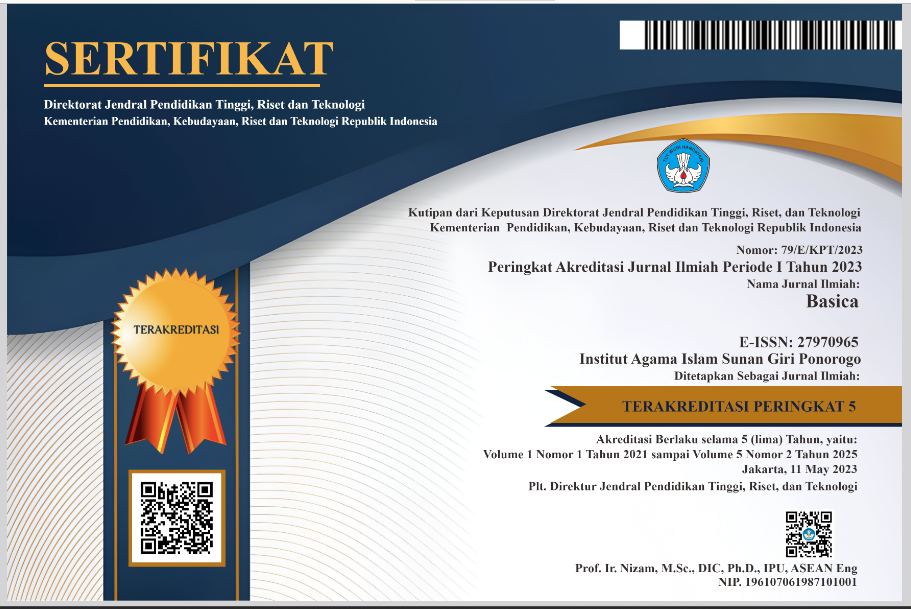The Impact of Gadget Use on the Social Development of Elementary School Students
DOI:
https://doi.org/10.37680/basica.v5i1.6904Keywords:
Handphone, Impac, Social DevelopmentAbstract
This study aims to determine the positive and negative impacts of using handphone both at school and at home, on the social development of fifth grade students of Al Fattah Islamic Elementary School. The method used in this study is a qualitative descriptive research type that focuses on case studies. The subjects studied were fifth grade students of Al Fattah Islamic Elementary School. Data collection was conducted through observation, questionnaires, and interviews condensation with 10 fifth grade students selected using purposive sampling techniques. The data analysis technique used was the Miles, Huberman, & Saldana, namely data, data presentation, and drawing conclusions. The results of the study show that the impact of mobile phone use on students includes positive and negative impacts, where the negative impacts are greater than the positive impacts. The negative impacts of handphone use are that it makes students dependent, reduces students' social interaction with peers and the surrounding environment, students are less active in discussions or group work, students often say and behave impolitely, and students become indifferent to the surrounding environment and tend to be more interested in virtual interactions than direct interactions so that they become passive individuals and develop towards anti-social individuals. While the positive impacts of handphone use are that students find it easier to communicate with friends and find information or learning materials that are not yet known.
References
Afandi, M., Ismiyanti, Y., Yustiana, S., & Apriliya, B. F. (2024). The Influence of The Monopoly-Assisted PAKEM Model on Students’ Critical Thinking Skill in Elementary School. 10(1), 37–50.
Ames, H., Glenton, C., & Lewin, S. (2019). Purposive sampling in a qualitative evidence synthesis: A worked example from a synthesis on parental perceptions of vaccination communication. BMC Medical Research Methodology, 19(1), 1–9.
Andriyani, Y., Arifin, M. H., & Wahyuningsih, Y. (2021). Dampak Negatif Penggunaan Gadget Terhadap Perilaku Siswa Sekolah Dasar di Era Globalisasi. Pendas: Jurnal Ilmiah Pendidikan Dasar, 6(2), 175–185.
Ariston, Y., & Frahasini. (2018). Dampak Penggunaan Gadget Bagi Perkembangan Sosial Anak Sekolah Dasar. Journal of Educational Review and Research, 1(2), 86–91.
Aziz, M., & Nurainiah, N. (2018). Pengaruh Penggunaan Handphone Terhadap Interaksi Sosial Remaja Di Desa Dayah Meunara Kecamatan Kutamakmur Kabupaten Aceh Utara. Jurnal Al-Ijtimaiyyah, 4(2), 19. https://doi.org/10.22373/al-ijtimaiyyah.v4i2.4204
Cahyaningtyas, A. P., Ismiyanti, Y., & Salimi, M. (2022). A Multicultural Interactive Digital Book: Promoting Tolerance and Multiculturalism to Elementary School Students. AL-ISHLAH: Jurnal Pendidikan, 14(3), 4079–4096.
Ismiyanti, Y., Permatasari, D., Mayasari, N., & Qoni’ah, M. (2023). The Impact of Video-Based Learning to Cognitive Learning Outcome of Student in Elementary School. JIP Jurnal Ilmiah PGMI, 9(1), 51–60. https://doi.org/10.19109/jip.v9i1.17270
Maulidiana, L. N., Cahyaningtyas, A. P., & Ismiyanti, Y. (2021). Development of Digital Interactive Module “E-MOSI” (Elektronik Modul Puisi) for Grade IV Students of Elementary School of Kemala Bhayangkari 02. EduBasic Journal: Jurnal Pendidikan Dasar, 3(2), 137–148.
Munisa. (2020). Pengaruh Penggunaan Gadget Terhadap Interaksi Sosial Anak Usia Dini Di TK Panca Budi Medan. Jurnal Abdi Ilmu, 13(1), 102–114.
Nihaya, F., Rahmawati, A., & Nurjanah, N. E. (2022). Dampak Penggunaan Gadget Pada Perilaku Sosial Anak Usia 5-6 Tahun. Kumara Cendekia, 12(1), 85–93.
Nuraliyah, E., Fadilah, A., Handayaningsih, E., Ernawati, E., & Oktadriani, S. L. (2022). Penggunaan Handphone dan Dampaknya bagi Aktivitas Belajar. Ideas: Jurnal Pendidikan, Sosial, Dan Budaya, 8(4), 1585. https://doi.org/10.32884/ideas.v8i4.961
Nuramadan, D. K., Muttaqin, Z., Fauziah Fatah, V., & Z, D. (2023). Ketergantungan Handphone pada Remaja. Jurnal Keperawatan Indonesia Florence Nightingale, 3(1), 31–36.
Putri, A., & Khadijah, K. (2024). Pengaruh Penggunaan Gadget Terhadap Perkembangan Sosial Anak Usia 5-6 Tahun. Aulad: Journal on Early Childhood, 7(2). https://doi.org/10.31004/aulad.v7i2.677
Rahmalah, P. Z. (2019). Pengaruh penggunaan gadget terhadap pembentukan karakter anak usia dini. Prosiding Seminar Nasional Lppm Ump, 0(0), 302–310.
Rini, N. M., Pratiwi, I. A., & Ahsin, M. N. (2021). Dampak Penggunaan Gadget Terhadap Perilaku Sosial Anak Usia Sekolah Dasar. Jurnal Educatio Fkip Unma, 7(3), 1236–1241.
Sari, D. N. (2020). An Analysis of the Impact of the Use of Gadget on Children’s Language and Social Development. 449(Icece 2019), 201–204. https://doi.org/10.2991/assehr.k.200715.041
Sari, Y., Abidin, Z., Kusumadewi, R. F., Ismiyanti, Y., & Ulia, N. (2024). The Effectiveness of Virtual Augmented Reality-Based Media to Improve Students’ Critical Thinking Skill: An Experimental Study in Elementary School. 10(2), 76–23.
Sholihah, Nurpratiwiningsih, L., & Muamar. (2022). Pengaruh Kecanduan Bermain Gadget dan Kontrol Orang Tua Terhadap Prestasi Belajar Kognitif Peserta Didik Kelas V SD Negeri Kubangpari 02. Jurnal Ilmiah Wahana Pendidikan, 8(14), 317–325.
Singh, M. K. K., & Samah, N. A. (2018). Impact of Smartphone: A Review on Positive and Negative Effects on StudentsSejalan. Asian Social Science, 14(11), 83. https://doi.org/10.5539/ass.v14n11p83
Srinahyanti, S., Wau, Y., Manurung, I., & Arjani, N. (2019). Influence of Gadget: A Positive and Negative Impact of Smartphone Usage for Early Child. Annual Conference of Engineering and Implementation on Vocational Education (ACEIVE). https://doi.org/http://dx.doi.org/10.4108/eai.3-11-2018.2285692
Suryadi, A., Ranchman, G. A., Amelia, R. putri, & Rahayu, T. citra. (2021). Penggunaan Handphone Pada Remaja Terhadap Interaksi Sosial. Cebong Journal, 1(1), 15–19. https://doi.org/10.35335/cebong.v1i1.5
Tullah, R., & Amiruddin. (2020). Penerapan Teori Sosial Albert Bandura Dalam Proses Belajar. Jurnal Pendidikan Agama Islam, 6(1), 48–55.
Witasari, R. (2024). Belajar dan Pembelajaran dari Perspektif Teori Kognitif , Behaviorisme Konstruktivisme dan Sosiokultural. Basica, 3(2), 257–268. https://doi.org/10.37680/basica.v3i2.5764
Zain, Z. M., Jasmani, F. N. N., Haris, N. H., & Nurudin, S. M. (2022). Gadgets and Their Impact on Child Development. Mcmc, 6. https://doi.org/10.3390/proceedings2022082006
Downloads
Published
How to Cite
Issue
Section
License
Copyright (c) 2025 Rasmi Yanti, Yulina Ismiyanti

This work is licensed under a Creative Commons Attribution-NonCommercial 4.0 International License.





